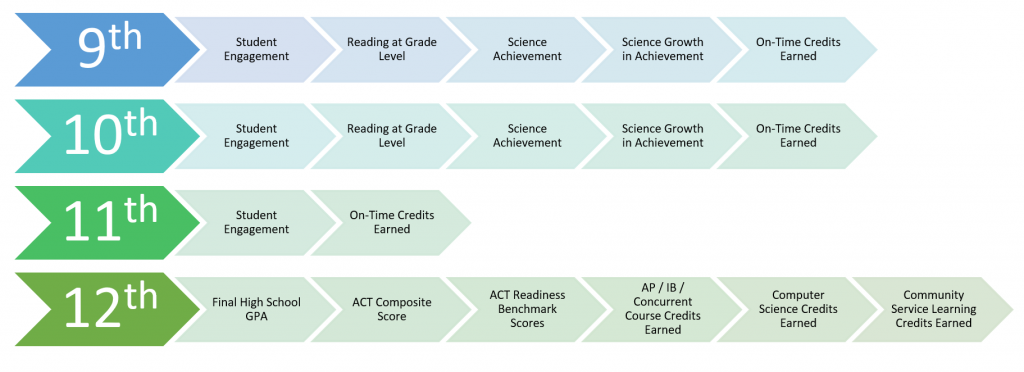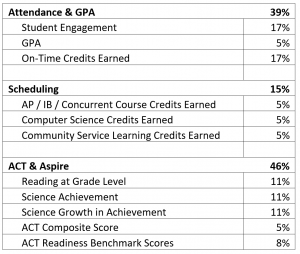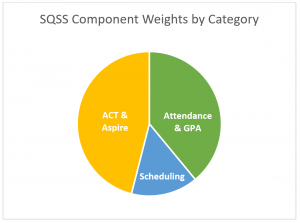In this article, you’ll find a brief description of the new School Quality and Student Success metric (SQSS) and the eleven components that go into calculating it. You’ll also learn about how important each component is for your overall SQSS score. We also discuss preliminary strategy considerations for maximizing SQSS.
The Arkansas Department of Education recently released its draft “Business Rules for Calculating ESSA School Index Scores” (available in full here), including details about calculating SQSS scores.
For Arkansas high schools, SQSS makes up 15% of the total ESSA School Index, the same weight given to Graduation Rate Indicators. Eleven components contribute to the SQSS calculation.
While the document is very explicit about how to calculate SQSS, its technical nature can make it quite difficult to gain an intuitive grasp of each component and its relative importance to the overall score.
In this article, we have created a summary definition for each component. (Please refer to the technical document for full specifications.) We have also distilled the relative weight of each SQSS component for a typical grades 9–12 high school and break down each SQSS component by grade (since not all SQSS components apply to all grades.)
The component summaries are also available as a downloadable document that your teachers might find helpful in understanding the draft ESSA School Index system (available by clicking here). The relative weight information and grade-by-grade breakdown can help you strategize on improving SQSS and aligning with what the state seeks to emphasize through the new Index.
SQSS Scoring
Each student in your school earns SQSS points. Your school’s SQSS score is calculated by taking the total number of SQSS points your students earn and dividing that by the total number of points your student could have earned.
Students in different grades can earn different numbers of points since certain components only pertain to certain grades.
Component Summary
Student Engagement
Students who do not miss many days of school earn points. A student who misses less than 5% of days enrolled earns 1 point. Missing 5% to less than 10% of school days earns 0.5 points. Missing more than 10% of enrolled school days nets 0 points.
Reading Achievement
Students who meet the benchmark on ACT Aspire Reading earn points. Students earn 1 point for achieving Ready or Exceeds and 0 points if they don’t.
Science Achievement
Students who meet the benchmark on ACT Aspire Science earn points. Students earn 1 point for achieving Ready or Exceeds and 0 points if they don’t.
Science Value-Added Growth
Students earn points for exceeding growth expectations on the ACT Aspire Science test. If growth meets or exceeds the 75th percentile, students earn 1 point. Growth ranked between the 25th and 75th percentiles nets 0.5 points. Students with growth ranked below the 25th percentile earn 0 points.
On-Time Credits
Students averaging at least 5.5 credits per grade earn 1 point. Otherwise, students earn 0 points. This equates to 5.5 credits by the end of 9th grade, 11 credits by the end of 10th grade, and 16.5 credits by the end of 11th grade.
High School GPA
12th-graders with a final high school GPA of 2.8 or higher receive 1 point. GPAs below 2.8 earn 0 points.
ACT Scores
12th-graders who have earned an ACT Composite score of 19 or greater on at least one ACT test administration receive 1 point. Students whose best ACT Composite score is 18 or lower receive 0 points.
ACT Readiness Benchmarks
12th-graders earn 0.5 points for each ACT College Readiness Benchmark they meet in Math (22), Reading (22), and Science (23). The best scale score the student has ever received can be used for each subject.
AP / IB / Concurrent Credit
Students receive 1 point if they earn one or more AP/IB/Concurrent Credit course credits, and 0 points if they don’t.
Computer Science
Students gain 1 point if they have earned one or more computer science course credits.
Community Service
Students who earn one or more Community Service course credits gain 1 point.
SQSS By Grade
Below is a diagram (download printable here) that provides a breakdown of the SQSS components measured for each high school grade level.

Relative Weight of SQSS Components
For this analysis of the relative weight of each component (and for the discussion that follows), we group the components into three major categories: Attendance & GPA, ACT & Aspire, and Scheduling. Click each image for a larger view.


(Weights assume the standard Arkansas distribution of students by grade level: 26% 9th-graders, 26% 10th-graders, 25% 11th-graders, and 23% 12th-graders.)
Strategic Considerations for Maximizing SQSS
What follows are our first impressions on general strategy for maximizing SQSS. Consider them as conversation starters for your team.
Scheduling
15% of SQSS is directly related to your students earning at least one credit in each of the following three categories by the time they graduate:
- AP / IB / Concurrent Credit
- Computer Science
- Community Service Learning
For many campuses, these components’ scores can quickly improve with some planning. Consider asking your team these or similar questions:
- What is the availability of AP / IB / Concurrent Credit courses?
- Are there any changes we could make to our AP / IB / Concurrent Credit course selection to make this pathway appealing to a broader base of our students? Are there particular AP / IB / Concurrent Credit courses we could offer that students who aren’t traditionally enrolling in these course types would find appealing and be successful in?
- Are there enough computer science classes (of varying difficulty and interest levels) to accommodate all of our students earning at least one credit in computer science by 12th grade?
- If you have a Community Service Learning program, what can be done to broaden its appeal? If you don’t, what needs to be done to get it off the ground?
- What can we do in terms of counseling and scheduling to ensure that the maximum number of students graduate with at least one of each of these three credit types?
Attendance & GPA
39% of your SQSS will be tied to the following group of components:
- Student Engagement (Attendance)
- GPA
- On-Time Credits Earned
Schools with a robust early warning system that enables its educators to be responsive to fluctuations in a student’s attendance and grades will be better equipped to improve these outcomes. Any student who misses less than 5% of school days, whose GPA remains at or above 2.8, and who consistently earns at least 5.5 credits per grade, will earn maximum points. To that end, consider these conversation starters with your team:
- How do we observe our students’ grades and attendance? Is this information sufficiently updated and reviewed with enough frequency for us to be informed, take action, and effect change? What can we do to improve the visibility and usability of this data?
- What can we do to improve the efficacy of attendance and grade-related interventions?
- How can we respond to early warning signs more quickly and more robustly?
- What can we do to identify and provide additional support for students with GPAs near 2.8, for students who are at risk of earning only 5 credits in a year, and for students on pace to miss 5% or more school days?
ACT & Aspire
46% of your SQSS is derived from ACT and Aspire scores tied to these components:
- Reading at Grade Level
- Science Achievement
- Science Growth in Achievement
- ACT Composite Score
- ACT Readiness Benchmark Scores
Schools able to exceed ACT growth expectations through robust supports aligned to the ACT College Readiness Standards are in a good position to improve SQSS scores. For your 9th– and 10th-graders, this means programming designed to boost Reading and Science outcomes. In 11th and 12th grade, this category is defined by concerted efforts to prepare students for the ACT and encourage students to re-test. What follows are a few strategic considerations you may want to discuss with your team:
- What can we do to provide students with additional support for the ACT Aspire Reading and Science tests?
- How can we identify students who are projected to score near a 19 on the ACT? What can we do to provide additional support to these “bubble students” and increase the percentage of students meeting that threshold?
- What process can we use to identify students who are within two or three points of achieving benchmarks (22 in Math and Reading and 23 in Science)? What targeted supports can we provide students to help them achieve this?
- What is our ACT preparation plan for our juniors and seniors? How can we bolster this?
- How can we, through counseling, mentorship, and communication, encourage our students to take the ACT multiple times and use their waivers if they have them?
- How can we develop a student culture that values college readiness and success on the ACT?
Final Thoughts—For Now
We will be sure to update you as we continue our analysis and particularly if the Arkansas Department of Education releases any further evolutions or clarifications to the ESSA School Index rules.
Until then, I leave you with an idea that I always feel obliged to express whenever I delve into improving accountability performance. This article has been very focused on how the new scoring system will work, and how one might shift priorities to improve scores. I save this note until last because it is far more unsolicited advice than test analysis: It goes without saying that a score, in the end, is just a number. In my experience, school districts don’t sustain accountability score gains unless those score gains actually mean something. If a school is forcing students into AP courses from which their students have no hope of gaining college credit, if it teaches to the test from sunup to sundown, if it screams to its students through a thousand tiny actions that they are point buckets, its best team members are going to become demoralized, its stakeholders will lose their enthusiasm, and any gains the school makes on the short run will disintegrate.
There’s an added step that I would recommend appending to each of the major discussion categories I listed above. Ask a version of this question: “How is improving our ESSA School Index (or SQSS points from scheduling, etc.) going to help our students?” And if there is any action that your team plans with the best of intentions that will increase your Index but that deep down they feel won’t help your students, nix it. The only way to form a strong, student-first team is to be willing to have your Index go down in flames if it means you’re putting students first. From this ethic can grow the genius of the AND. It is usually possible to help students AND in the process increase Index scores. Kill the noise and complaining about the accountability system by drawing a firm line in the sand about students coming first. Keep your actions and decisions consistent with this and ask your team what parts of the new scoring system they are most excited about. What do they feel will end up being good for students across the state? Challenge your team to make the state’s Index changes and your local drive for Index improvement translate into good things for students on your campus. This is, in my opinion, a firm foundation for any initiative to improve school performance.